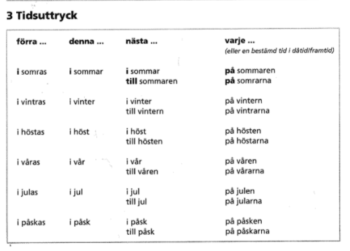Swedish Expressions of Time – Round två! Posted by Chelsea B on Feb 19, 2021 in Swedish Language, Vocabulary
Are you ready for Swedish Expressions of Time – Round två?! In last week’s post, I gave you three tips to build a solid foundation with Swedish tidsuttryck. To build on this for today, we’ll cover additional present tense expressions, and examine the way Swedish prepositions i and på accompany expressions of time throughout the tenses.
“This Week” and “That Year”
The way we express “this” and “that” varies in Swedish. But in the case of time expressions, start with the noun you want to use. It is day, week, or year? Then we must get its article right. Is it an en, or an ett noun? Or is it plural?
en dag → dagar a day → days
en månad → månader a month → months
ett år → år a year → years
en vecka → veckor a week → weeks
en morgon → morgnar a morning → mornings
en vinter → vintrar a winter → winters
Once we know its article, we can add the first part of the phrase, either den, det, or de.
Den corresponds to singular en nouns, det corresponds to singular ett nouns, and de corresponds to plural nouns (regardless of the en or ett in their singular form). Add här for “this” and där for “that.” De + här or där becomes “these” or “those.” Top it off with the definite (or bestämd) form of the noun. For example:
den här veckan → this week
den här månaden → this month
det här året → this year
de där dagarna → those days
de här veckorna→ these weeks
Prepositions i and på – Present and Past
Folkuniversitetet’s Form i fokus Del A, sorts i and på nicely with the graphic below. The authors provide four categories at top of the chart; förra, denna, nästa, and varje. Each of these is used to help us distinguish the time frame. Let’s review those first, as they are tidsuttryck on their own:
förra = last, past tense
Use this with the definite form of the noun
förra sommaren → last summer
denna/detta = this or that present tense
Use denna or detta depending upon the article of the noun. Then combine it with the indefinite form of the noun
denna sommar → this summer
detta år → this year
nästa = next, future or present
Use nästa with the indefinite form of the noun
nästa sommar → next summer
varje = every or each, present tense
Use this to describe something that happens regularly or seasonally. Varje is paired with an indefinite noun.
varje sommar → every summer
Now use these 4 categories to look at the i versus på phrases throughout the tenses. Note that there are several variations in the nouns, too!
Swedish Expression of Time Practice Exercise
Put your knowledge to the test and translate these sentences from English into Swedish using the tidsuttryck we covered today and last week:
- Next summer we’re going to Europe.
- This winter the family is going skiing.
- Last August we went to Sweden.
- We travel abroad each spring.
- The orchestra played in Rome last year.
- In the fall of 2018 he’s moving
- They have made ginger cookies every Christmas.
- Sigge gets a walk in the mornings.

Build vocabulary, practice pronunciation, and more with Transparent Language Online. Available anytime, anywhere, on any device.





